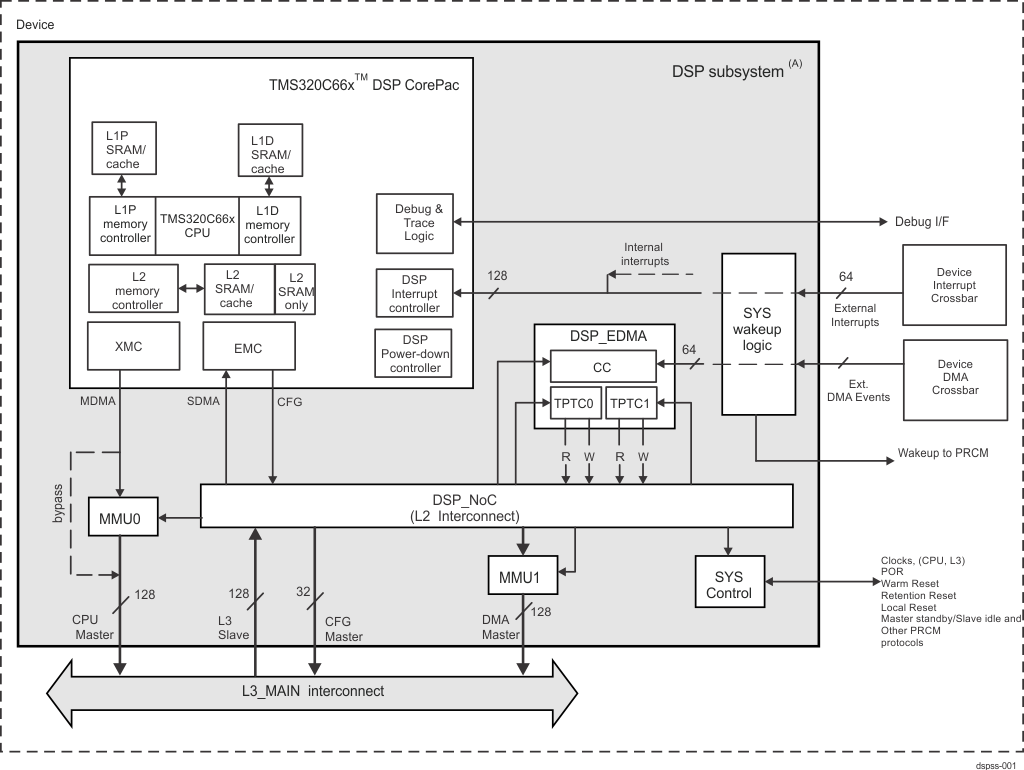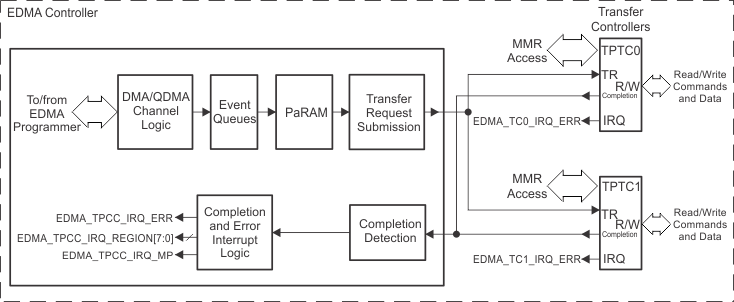SPRAC21A June 2016 – June 2019 OMAP-L132 , OMAP-L138 , TDA2E , TDA2EG-17 , TDA2HF , TDA2HG , TDA2HV , TDA2LF , TDA2P-ABZ , TDA2P-ACD , TDA2SA , TDA2SG , TDA2SX , TDA3LA , TDA3LX , TDA3MA , TDA3MD , TDA3MV
-
TDA2xx and TDA2ex Performance
- Trademarks
- 1 SoC Overview
- 2 Cortex-A15
- 3 System Enhanced Direct Memory Access (System EDMA)
- 4 DSP Subsystem EDMA
- 5 Embedded Vision Engine (EVE) Subsystem EDMA
- 6 DSP CPU
- 7 Cortex-M4 (IPU)
- 8 USB IP
- 9 PCIe IP
- 10 IVA-HD IP
- 11 MMC IP
- 12 SATA IP
- 13 GMAC IP
- 14 GPMC IP
- 15 QSPI IP
- 16 Standard Benchmarks
- 17
Error Checking and Correction (ECC)
- 17.1 OCMC ECC Programming
- 17.2 EMIF ECC Programming
- 17.3 EMIF ECC Programming to Starterware Code Mapping
- 17.4 Careabouts of Using EMIF ECC
- 17.5 Impact of ECC on Performance
- 18 DDR3 Interleaved vs Non-Interleaved
- 19 DDR3 vs DDR2 Performance
- 20 Boot Time Profile
- 21 L3 Statistics Collector Programming Model
- 22 Reference
- Revision History
4 DSP Subsystem EDMA
The DSP subsystem is built around the high-performance TI's standard TMS320C66x™ DSP CorePac core. The subsystem includes EDMA and L2 interconnect to facilitate high-bandwidth transfers between chip-level resources/memory and DSP memory.
The DSP subsystem inputs a primary /1 (dsp_clk) and internally generates the /2 (clk2) or /3 (clk3) or /4 (clk4) clock rates. The division is defined upon device boot time through a signal level externally applied on the device sysboot15 input. The actual bit configuration is latched upon power-on reset by the CTRL_CORE_BOOTSTRAP[15] SYS_BOOT_15_CLOCK_DIVIDER boot status bit in the TDA2xx and TDA2ex Control Module Registers. Only DSP_CLK3 clock is supported on TDA2xx and TDA2ex. Sysboot[15] must be pulled to vdd for proper device operation (SR1.x). For SR2.0, it is used to permanently disable the internal PU/PD resistors on pads gpmc_a[27:19]. For SR2.0 the DSP EDMA always operates at clk3.
The different portions of the DSP subsystem run at the DSP_CLK3 and DSP_CLK, as shown in Figure 13.
 Figure 13. DSP Subsystem Block Diagram and Clocking Scheme
Figure 13. DSP Subsystem Block Diagram and Clocking Scheme This section provides a throughput analysis of the DSP SS EDMA module. The enhanced direct memory access module, also referred to as EDMA, performs high-performance data transfers between two slave points, memories and peripheral devices without the digital signal processor (DSP) support during transfer. EDMA transfer is programmed through a logical EDMA channel, which allows the transfer to be optimally tailored to the requirements of the application. The EDMA can also perform transfers between external memories and between device subsystems internal memories, with some performance loss caused by resource sharing between the read and write ports.
The EDMA controller block diagram is shown in Figure 14. The EDMA controller is based on two major principal blocks:
- EDMA third-party channel controller (EDMA_TPCC)
- EDMA third-party transfer controller (EDMA_TPTC)
The EDMA controller’s primary purpose is to service user-programmed data transfers between internal or external memory-mapped slave endpoints. It can also be configured for servicing event driven peripherals (such as serial ports), as well. There are 64 direct memory access (DMA) channels and 8 QDMA channels serviced by two concurrent physical channels.
 Figure 14. DSP Subsystem EDMA Block Diagram
Figure 14. DSP Subsystem EDMA Block Diagram DMA channels are triggered by external event, manual write to event set register (ESR), or chained event. QDMA are auto-triggered when write is performed to the user-programmable trigger word. Once a trigger event is recognized, the event is queued in the programmed event queue. If two events are detected simultaneously, then the lowest-numbered channel has highest priority. Each event in the event queue is processed in the order it was queued. On reaching the head of the queue, the PaRAM associated with that event is read to determine the transfer details. The transfer request (TR) submission logic evaluates the validity of the TR and is submits a valid transfer request to the appropriate transfer controller.
The maximum theoretical bandwidth for a given transfer can be found by multiplying the width of the interface and the frequency at which it transfers data. The maximum speed the transfer can achieve is equal to the bandwidth of the limiting port. In general, a given transfer scenario will never achieve maximum theoretical band width due to several factors, like transfer overheads, access latency of source/destination memories, finite number of cycles taken by EDMA CC and EDMA TC between the time the transfer event is registered to the time the first read command is issued to EDMA TC. These overheads can be calibrated by looking at the time taken to do a 1 byte transfer. These factors are not excluded in these throughput measurements.